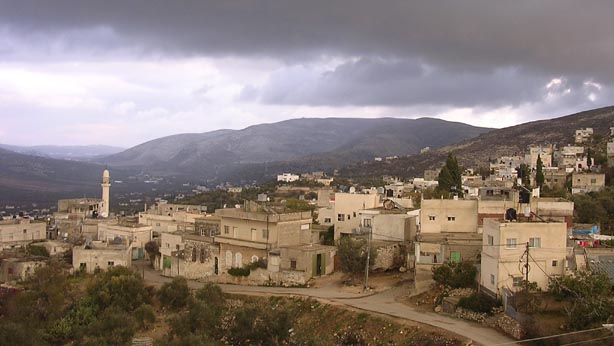- Fandaqumiya
Infobox Palestinian Authority muni
name=Fandaqumiya
imgsize=250
caption=Viewpoint of village, the nearby village and fortress of Sanur can be seen in the background
arname=الفندقومية
meaning=
founded=
type=mund
typefrom=
altOffSp=al-Fandaqumiya
altUnoSp=Pentakomia
governorate=jn
latd=32|latm=19|lats=13.17|latNS=N
longd=35|longm=12|longs=13.00|longEW=E
population=3,363
popyear=2006
area=3,895
areakm=3.9
mayor=Fandaqumiya, (Arabicالفندقومية, "al-Fandaqumiyah", "Pentakomia") is a village located in the
Jenin district of the northernWest Bank , northwest ofNablus . According to thePalestinian Central Bureau of Statistics , the town had a population of 3,363 inhabitants in mid-year 2006. [ [http://www.pcbs.gov.ps/Portals/_pcbs/populati/pop01.aspx Projected Mid -Year Population for Jenin Governorate by Locality 2004- 2006]Palestinian Central Bureau of Statistics ]Name
The Arabic name of the village, Al Fandaqumiyah (الفندقومي), is a corruption of the Greek term Pentakomia: "Komia" means 'village' or 'community', while "penta" means 'five'. Pentakomia probably refers to an administrative unit of five villages which existed in the area.
A Pentakomia in
Greece Fact|date=February 2007 as well as one on the Euphrates River ["There is a locality of this name in Arabia" CathEncy|wstitle=Pentacomia] probably share theetymology , and theHebron area village ofTarkumiya (Arabic ترقوميا) is based on the Greek "Trikomia", or 'community of three.'Geography
The village is in the northern West Bank, on the road leading north from
Nablus toJenin . It is located between the ancient ruins ofSamaria and Sebaste and theSanur Valley . It is also neighbored by the villages ofJaba andSilat al Dahar , as well as the former settlements ofHomesh andSa-Nur , which were dismantled inIsrael's unilateral disengagement plan .The following are maps that show the village location. From left to right, the maps zoom to the village area.
History
Pre-Historic Period
The earliest findings in Fandaqumiya include a white clay jar filled with burned bones, which was found in a tomb. The examination of this jar at the Archaeological Department of the
An-Najah National University suggested that it be dated to the Neolithic Period. A stone tool, circular in shape with a hole in the middle, was found alongside the jar, though it was never datedFact|date=February 2007.Hellenistic Period
Two coins dating back to the Greek period were found in the village. A
prutah minted byHasmonean rulerAlexander Jannaeus between 103 and 76 BCE, as well as a Greek coin of the Ptolmaic dynasty dated to the year 300 BCE.Roman & Byzantine Period
There is evidence that the village flourished during the Early Roman and Late Byzantine periods. Many Roman and Byzantine coins were discovered on site, and many tombs from the same period were found in a nearby hill. Additionally several structures characteristic of the Roman and Byzantine periods have been unearthed.
The Ottoman Period
Several coins and structures, including a mosque, may date from the Mamluk period, however very little else is known about the site during that stageFact|date=February 2007.
The modern settlement was renewed in 1820 when Ahmad Anbar and his family arrived from Hebron and were granted a homestead in the well-known ruin by the local ruler of the Sanur area, Haj Ahmad JarrarFact|date=February 2007. Because Haj Ahmad operated independent of the Ottomans, the Sanur fortress was besieged by the authorities around 1830, and many of the local villages were pillaged, including Fandaqumiya. While the population had fled during the hostilities, the village was eventually repaired and more families continued to arrive.
A spur of the Ottoman
Hejaz railway toDamascus was built through the area, and a station was opened nearby at Sebastia. Unfortunately, after the collapse of the Ottomans, locals took apart the rail infrastructure for secondary use in construction. Many of the steel beams can still be seen in the roofs of local homes.The British Mandate
In 1917, Fandaqumiya was captured by the British forces from the Ottomans, and three years later it was assigned to the British
Mandate for Palestine .Soon after the British arrived, they built a police fort on a nearby hill. Despite many villagers being employed in the construction, relations with the British forces were at times rocky owing to tax disputes. During the riots of 1936-1939, some villagers launched attacks on the British troops, and the village was subject to British reprisals.
During the 1940s, the British administration funded modern water and agriculture development projects as well as an elementary school.
The Modern Period
After the
1948 Arab-Israeli War , Fandaqumiya was ruled by theHashemite s ofJordan . Al Fandaqumiya passed toIsrael i control along with the rest of the West Bank after the 1967Six-Day War , though after the 1995 signing of theInterim Agreement on the West Bank and the Gaza Strip , it has been administered by the Palestinian Authority.References
Wikimedia Foundation. 2010.
